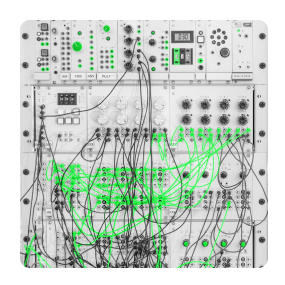
World´s first reconfigurable discrete analog computer
The small system primarily serves as a technological demonstrator for early adopters and education. While the capabilities in terms of the problem size are limited, it is still very interesting for electronic laboratories given it's excellence in low latency real-time applications. One of such use cases is in test facilities and control systems, where only a small number of observables has to be tightly tracked or predicted.

# Set alias for cluster
set-alias * carrier
set-alias carrier/0 cluster
set-alias cluster/M0/0 osc_x
# Configure routing on cluster
route -- cluster 8 0 1.0 9
Truly multi purpose
The advantages of analog computers, such as extreme computing speed combined with minimal energy consumption, are well known. However, the main disadvantage of classic analog computers is their inflexibility, as a very time-consuming manual reconfiguration has to be done for every application case. Not so with the lucidac - thanks to its digital control, it can be reconfigured by software within the blink of an eye.
Applications

Robotics
For the development of control methods based on an analog computer for the highly dynamic control of robots using exteroceptive sensors an application kit including software will be provided. Because the sensors and the robot controller can be connected directly to the lucidac, the commissioning time is reduced and the dynamic performance is significantly increased. As a result, significant obstacles to the spread of robot-guided disassembly and assembly applications can be removed.

Better speech recognition
Analog signal processing can improve speech recognition and control systems, enabling more accurate and responsive interaction with the user. Analog processing can filter and pre-process audio signals to improve speech recognition accuracy and reduce latency in voice-controlled devices.

Automotive electronics
Analog signal processing can play a crucial role in ADAS applications such as collision detection, lane departure warning and adaptive cruise control. Analog processing can efficiently extract and analyze sensor data from cameras, radar and LiDAR systems, enabling safer and more autonomous driving.
What’s your case?
Programming your lucidac
Programming a LUCIDAC is straightforward due to its intuitive software interface and comprehensive support for multiple programming languages, including Python, C++, and Julia. The device features a sophisticated auto-calibration system and a user-friendly browser-based GUI that simplifies the configuration and management of complex computations. Additionally, LUCIDAC's software library provides robust examples and detailed documentation, enabling users to quickly implement and run custom analog computing programs with minimal effort. This ease of use makes LUCIDAC accessible to both novice and experienced programmers, facilitating rapid development and deployment of analog computing solutions.

Specs
Analog
Digital
355 x 100 x 158 mm³ (width x height x depth, including case)
Product LifetimeMarket launch expected in September 2024. Compatible extensions will be released in 2025.
External connectorsRJ45 for 10/100 BASE-TX Ethernet (100Mbit/sec)
16 MCX female coaxial connectors for Analog I/O
2x25 IDC header with latches for Digital I/O for use with standard flat cables.
8x LEDs for system status (four user controllable)
3x MCX trigger output (for IC/OP/Overload detection)
USB-C for backup serial console and flashing (USB2)
Up to 12bit resolution.
DC accuracy 0.1%
AC bandwidth > 1Mhz (cutoff frequency).
Analog computing elements can be coupled all-to-all (max 32 non-zero items in 16x16 connection matrix).
Computing LevelsThe logical computing domain is [-1,+1] and internally encoded in either voltages or currents. The external I/O is voltage coupled in [-2,+2] V.
Each LUCIDAC is equipped with a Teensy 4.1 which is a 600Mhz Cortex-M7 with 7MB flash, 1MB RAM, 480mbit/sec USB2 and 10/100mbit Ethernet. The modular hybrid controller board furthermore features external high quality 16bit ADCs.
FirmwareThe firmware runinng on the integrated microcontroller is supposed to be open sourced at Github. It is simple yet modern Arduino code using Platformio and counts roughly 20.000 LOC.
SoftwareThere is client software available in various programming languages, such as Python, C/C++, Go, TypeScript, Julia, Rust and others. The communication over USBSerial or Network is a simple plaintext JSON protocol.
Graphical User Interface (GUI)The GUI is served by the embedded webserver within LUCIDAC and allows to use the device without any software on any device in the same network.
Funded by



